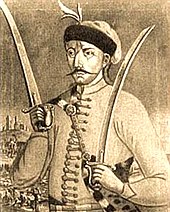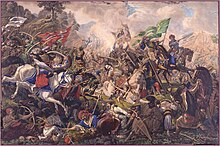Pál Kinizsi
Pál Kinizsi , also Romanian Pavel Chinezul or Paulo de Kynys (* around 1431 in Smederevo (other sources give Timişoara (today Timișoara ) as his place of birth); † November 24, 1494 in Sankt Clemens near Smederevo) was a general in the Kingdom of Hungary . His extraordinary physical strength gained a legendary reputation.
Life
Kinizsi was the son of a miller. As a non-commissioned officer under the leadership of Balázs Magyar , Kinizsi first attracted attention in 1468 in a campaign against Transylvania . His fighting style with two swords characterized him so that he was promoted to commander. Matthias Corvinus soon transferred the office of Severin Ban to him .
In 1472 he received the Vázsony Castle near Nagyvázsony near Lake Balaton , including the lands belonging to the castle, from Matthias Corvinus for his services . The Kinizsi Castle later became a castle and barbicans extended (a horseshoe-shaped, two-story high Torschutz, led to the input of a narrow, resting on wooden pillars wooden bridge). In 1478 Kinizsi settled monks of the Pauline Order ( Hungarian pálos ) in Vázsony and had monasteries and churches built for them.
From 1478 to 1494 Kinizsi held the office of Temescher Comes .
On October 13, 1479, the Ottomans attacked Transylvania with 40,000 men under Pasha Alibeg of Semendria (Smederevo) . The Transylvanian Prince Stephan Báthory von Ecsed called Kinizsi for help, and together with Vuk Branković and Basarab Laiotă cel Bătrân they succeeded in killing 30,000 soldiers from the Ottoman forces in the battle on the bread field , with the rest of the attackers fleeing in panic.
Kinizsi married Benigna , the daughter of Baláz Magyar , around 1480 and obtained Somló Castle through their marriage .
Matthias Corvinus also appointed Kinizsi as general captain in 1481 ( Latin generalis capitaneus inferiorum partium regni ) and commissioned him with the protection of the southern parts of the empire. Kinizsi left Timisoara with 30,000 men in November 1482 to cross the Danube at Horom . He drove the Ottomans far back into Serbia . During this campaign Kinizsi also won a victory in front of the Golubach Castle . He returned from this campaign with 25,000 Serbs , who were afraid of the Ottomans, and settled them near Timisoara.
Kinizsi was affected by the armistice that Matthias Corvinus concluded with Bayezid II in 1483 and extended in 1488 for another three years. During this time of peace Kinizsi took care of the improvement of the fortifications in the area under his control. After the death of King Matthias Corvinus Kinizsi stood on the side of Vladislav II against János Corvin .
Maximilian I took Vázsony Castle in 1490, which Kinizsi recaptured a year later. After the death of Matthias Corvinus, the Hungarian nobles wanted to strengthen their power by choosing a weak king. Finally, Vladislav II , the son of the Polish king Casimir IV Jagiełło , succeeded Corvinus. His first undertaking was to eliminate the "Black Legion" ( Hungarian fekete sereg ), a Bohemian mercenary force founded by Corvinus to combat internal unrest. After being moved to Szeged , the Legion also caused unrest in Timisoara County with robbery, murder and arson. Comes Kinizsi got the order to integrate them into the army or to destroy them, with Kinizsi opting for the second variant.
In response to this, the Ottomans noticed movement, so Vladislav II decided to re-fortify the Timisoara. Kinizsi was in charge, and he used parts of his own fortune for this. In 1492 Vladislav II visited Timisoara to inspect the fortification work and stayed here for over a month. He was received by Kinizsi, who, despite his silence (he had lost his voice on the battlefield), swore allegiance to the king. The high nobility had failed to fulfill their military obligations, although the Ottomans threatened to crush Hungary. On January 28, 1494 Kinizsi was appointed Judex Curiae by the king . When the Ottomans invaded the Banat, he led his army across the frozen Danube and stormed two castles in which Ali Pasha kept his treasures. Kinizsi was able to leave with the treasures. The news reached him that conspirators wanted to play Belgrade into the hands of Ali Pasha. When Kinizsi arrived near Belgrade, the Ottomans were already starting to climb the ramparts. Kinizsi drove the Turks back from the walls and drove them out.
Then he hurried to meet the king, who was in Transylvania. Vladislav II arrived with the Transylvanian Prince Bartholomäus Drágffy on September 25, 1494 in Timisoara and stayed here until September 30. On this occasion Kinizsi threw himself at the king's feet, then he pointed to the Turkish border and full of enthusiasm “the old man took up his sword with the strength of a youth, as if he were already in the middle of the hot Turkish battle”. With 14,000 men he roamed and plundered Serbia with Drágffy . During the siege of Smederevo he suffered a fatal illness, from which he died on November 24, 1494 in Sankt Clemens . His successor as Temescher Comes, Captain General and Severin Banus was his pupil Josef von Somy .
Legends
In Hungarian and Romanian legends, the folk hero is referred to as the Hungarian Hercules .
As a young lad, Pál Kinizsi worked in his father's mill. King Matthias Corvinus is said to have stopped there with a hunting party on a hot summer's day. The visitors asked for wine, but the miller had only water to offer. Instead of a serving tray, Kinizsi is said to have offered the king the water cups on a heavy mill wheel, held by just one hand. The enthusiastic king is said to have called Kinizsi into his service.
Other legends say that Kinizsi is said to have participated in a knight tournament, where he threw a heavy mill wheel far with just one hand. Matthias Corvinus is said to have been so impressed by this that he called him to his service.
At the victory celebration after the battle on the bread field, the bloody corpses of the Ottomans were piled up on tables on which the Lord's Supper was also served. Then there was singing and dancing. When it was Kinizsi's turn, to the amazement of his soldiers, he is said to have taken the corpse of an Ottoman between his teeth while dancing and to carry another one under each arm.
Memorials
The modern statue in the courtyard of Nagyvázsony with Kinizsi on a horse was made from bronze by Ivan Szabo . Memorial plaques on the corner of Burgstrasse and Kinizsi Strasse commemorate him. His tombstone is in the Buda Castle Museum . The Kinizsi-szikla (Kinizsi Rock) monument stands in Somlo . In Budapest's Testnevelési Egyetem park there is a sculpture Pál Kinizsi, which was made by János Pásztor in 1932 . In the Romanian Șibot ( Unterbrodsdorf , Alba district ) there is a bust that is supposed to represent Pál Kinizsi.
In founded by Kinizsi Pauliner Burgkloster Nagyvázsony be today is him performing hand-carved sarcophagus . In 1708 grave robbers stole his mail shirt , helmet and two blades. However, the relics were later found and can now be seen in the Hungarian National Museum.
Trivia
The football club Chinezul Timișoara named itself after the folk hero Pavel Chinezu. The Timișoara rock band Transsylvania Phoenix sang Chinezu in 1974 on their album Mugur de fluier with the piece Pavel Chinezu, leat 1479 .
See also
literature
- Ioan Hațegan: Pavel Chinezu, in Romanian . Helicon, Timișoara 1994, ISBN 973-9159-83-4 .
- Puky Andor: A Kinizsi család és Bihar-megyében, in Hungarian . Turul, 1891.
- Németh Gábor: Adatok Nagy-Vázsony történetéből, in Hungarian . Veszprém 1901.
- Rácz Béla: Kinizsi Pál, in Hungarian . Veszprém 1940.
- Éri István: A nagyvázsonyi Kinizsi Vár, in Hungarian . Veszprém 1957.
- Zákonyi Ferenc: Nagyvázsony, in Hungarian . Győr 1977.
- Vázsonyi Varga Béla: Kinizsi Pál, in Hungarian . Veszprém 1988.
- Tatay Sándor: Kinizsi Pál (Ifjúsági r.), In Hungarian . Budapest 2011.
Web links
- banater-aktualitaet.de , Anton Zollner: The Temeschburg fortress under the Corvins
- banater-aktualitaet.de , Anton Zollner: Temeschburg before the peasant uprising
| personal data | |
|---|---|
| SURNAME | Kinizsi, Pál |
| BRIEF DESCRIPTION | Hungarian general |
| DATE OF BIRTH | 1431 or 1432 |
| PLACE OF BIRTH | Smederevo or Timișoara |
| DATE OF DEATH | November 24, 1494 |
| Place of death | Saint Clement near Smederevo |










